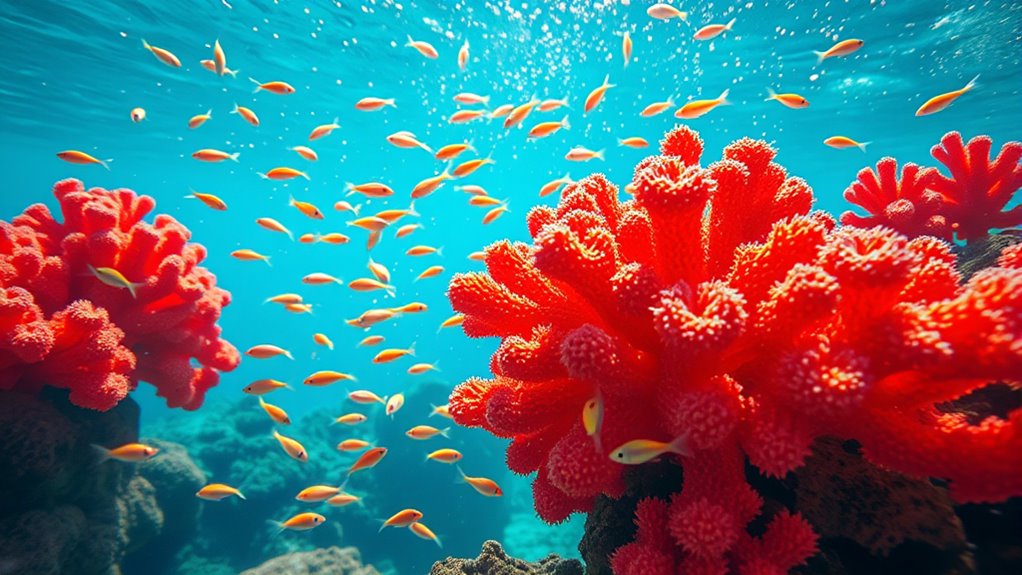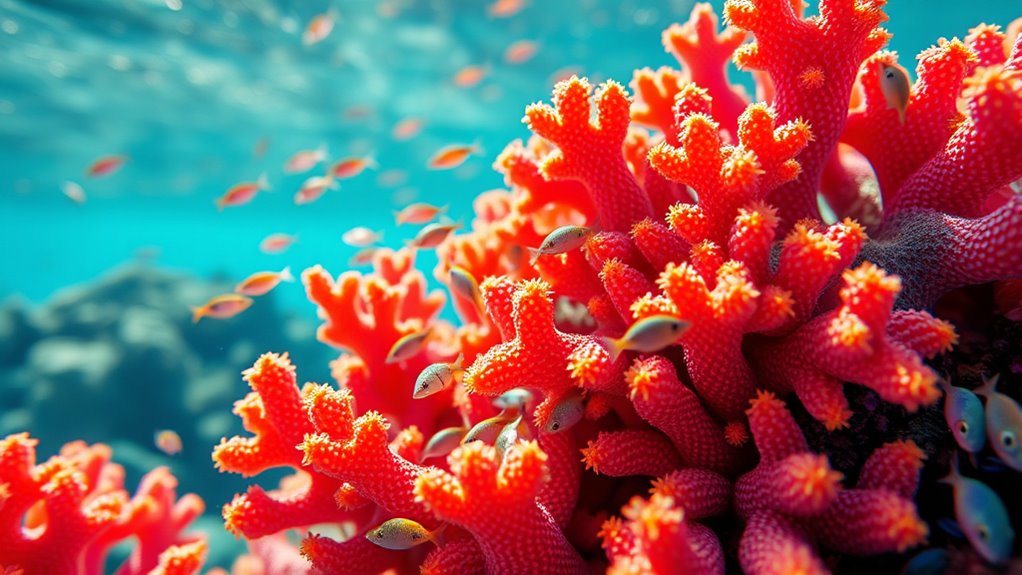3D-printed coral shapes are a breakthrough for marine restoration because they attract more juvenile fish by mimicking natural coral formations. These customizable structures provide safe habitats, encouraging fish to settle and helping reefs recover faster. Made from eco-friendly materials, they’re durable and easy to deploy, supporting larger-scale conservation efforts. As you explore further, you’ll discover how this innovative technology is transforming marine ecosystem recovery and biodiversity preservation.
Key Takeaways
- 3D-printed coral shapes mimic natural habitats, attracting juvenile fish and supporting reef regeneration.
- Customizable designs match specific environmental needs, increasing their effectiveness in attracting young fish.
- Eco-friendly, durable materials ensure safe and long-lasting structures resistant to ocean currents.
- These artificial structures help reduce pressure on fragile natural reefs during recovery efforts.
- Overall, 3D-printed coral shapes enhance biodiversity and aid in restoring healthy marine ecosystems.

As coral reefs face increasing threats from climate change and pollution, scientists are turning to innovative solutions like 3D printing to help restore these essential ecosystems. This breakthrough in coral reef restoration offers a promising approach to combat declining fish populations and damaged habitats. By creating artificial coral structures with precise designs, researchers aim to attract more juvenile fish, which are crucial for the health and resilience of marine ecosystems. These 3D-printed shapes mimic natural coral formations, providing safe spaces for baby fish to hide, feed, and grow. As you observe these innovations, it becomes clear how they could revolutionize marine conservation efforts, especially in areas where traditional coral transplantation struggles.
Innovative 3D-printed coral structures help restore ecosystems by attracting juvenile fish and supporting marine biodiversity.
The key advantage of 3D-printed coral shapes lies in their ability to be customized for specific environments. You can tailor the size, shape, and complexity of these structures to match local coral species and the needs of the native fish populations. This customization enhances the likelihood of attracting juvenile fish, which are often the most vulnerable to predators and environmental stresses. When these young fish find refuge in the artificial corals, they have a better chance to mature and eventually contribute to natural reef regeneration. This targeted approach accelerates coral reef restoration by providing immediate habitat relief while natural corals recover over time.
Furthermore, 3D printing allows scientists to use eco-friendly materials that are safe for marine life, ensuring that these artificial reefs don’t introduce harmful pollutants. You’ll find that this method also reduces the dependency on fragile natural reefs during the initial stages of restoration, giving ecosystems a much-needed boost. The structures are durable, resistant to ocean currents, and can be deployed quickly in damaged areas, making them practical tools for large-scale marine conservation efforts. As you consider the potential impact, it’s evident that these innovations could help stabilize fish populations and restore biodiversity more efficiently than traditional methods.
Additionally, integrating survival skills into marine conservation strategies can help communities better protect and maintain these artificial reefs, ensuring long-term success. The success of these 3D-printed coral shapes isn’t just about attracting baby fish; it’s about creating sustainable habitats that support entire ecosystems. By fostering healthier fish populations, we can improve the overall resilience of coral reefs against future threats. As you watch this technology advance, you’ll see how it aligns with broader goals of marine conservation—protecting the ocean’s biodiversity and ensuring the survival of crucial marine species. This breakthrough offers hope that, with continued innovation, we can restore and preserve coral reefs for generations to come, turning the tide against the damages inflicted by human activity and climate change.
Frequently Asked Questions
How Durable Are 3-D-Printed Coral Structures in Marine Environments?
You might wonder about coral durability in marine settings. 3D-printed coral structures, made from durable, marine-grade materials, stand up well against water erosion and biological growth. They promote material sustainability by resisting decay and minimizing environmental impact. While no structure is entirely permanent, these prints are designed for long-term use, ensuring they support marine life effectively without quickly breaking down or harming ecosystems.
Can These Coral Shapes Be Customized for Different Fish Species?
You’ll find that these coral shapes can indeed be customized for different fish species, offering habitat customization that benefits diverse marine life. Studies show that species-specific designs increase fish attraction by up to 40%. By tailoring shapes and textures to particular species, you help create more effective shelters and breeding sites, enhancing local ecosystems. This flexibility makes 3D printing a powerful tool for marine conservation and habitat restoration efforts.
What Materials Are Used to Print the Coral Shapes?
You might wonder what materials are used to print coral shapes. Typically, biodegradable plastics or biocompatible resins are selected because they are safe for marine environments. These materials guarantee the coral structures are environmentally friendly and durable enough to withstand underwater conditions. By using these eco-friendly options, you help protect marine life while creating attractive habitats for baby fish to thrive.
How Do These Structures Impact Local Marine Ecosystems Long-Term?
You might wonder how these structures affect marine ecosystems long-term. They boost ecosystem resilience by providing safe habitats, helping species recover more quickly from disturbances. By increasing habitat complexity, they also promote species diversity, supporting a balanced ecosystem. Over time, these artificial reefs can stabilize local environments, encouraging healthy growth of native species and fostering a more resilient, diverse community of marine life.
Are There Any Environmental Risks Associated With 3-D Printing Coral Habitats?
Like walking a tightrope, you need to consider pollution concerns with 3D-printed coral habitats. While they support marine life, improper materials could introduce toxins, disrupting the ecological balance. These risks highlight the importance of using environmentally safe, biodegradable substances. If not, pollution could harm local ecosystems, outweighing the benefits. Careful design and material choices are essential to ensure these structures serve as sustainable, positive additions rather than environmental hazards.
Conclusion
You might think that simply designing pretty coral shapes would attract more baby fish, but this breakthrough shows it’s all about how the structures are made. By using 3D printing, researchers created habitats that mimic real coral, making fish feel safer and more at home. It turns out, smart design really does matter—proving that blending technology with nature can boost marine life. So, next time, remember that innovation can help save our oceans, one tiny fish at a time.










